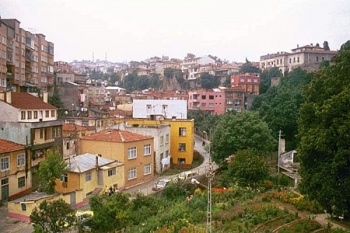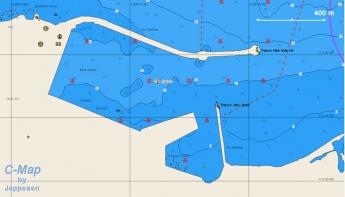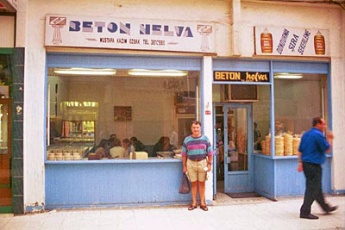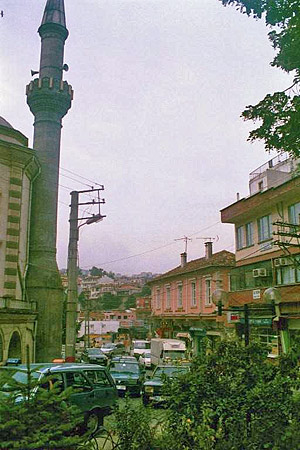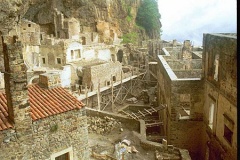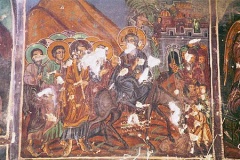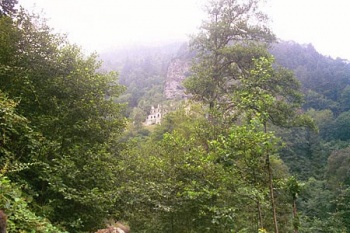Trabzon
From CruisersWiki
| Trabzon Port of Entry
| |
| | |
Modern Trabzon, although it is a bustling and fascinating town, architecturally is dreary like most towns in the region of the Black Sea. It has large concrete apartment buildings, in dreadful shape, gray, and run down.
Charts
- BA
- 2214 The Euxine or Black Sea
- 2236 Tirebolu to Tuapse
- 1279 Trapzon
- NIMA
- 55105 Eastern Part of the Black Sea
- Turkey
- 141 Tirebolu- Trabzon
- 1411 Trapzon Liman
Weather
See Turkey.
Passages
Popular passages/routes, timing, etc.
Islands
None.
Communication
Also see World Cruiser's Nets.
The approaches to Trabzon are straightforward.
Entrance
Trapzon is a port of entry/exit to Turkey. All the officials are housed in a blue building on the north-west corner of the harbor.
Berthing
Trapzon Harbor
The Harbor of Trapzon is the third largest commercial harbor in Turkey. It is a very busy harbor.
You are not allowed here to anchor off as in most Turkish Black Sea harbors. The best protection is on the north-west corner near the harbormaster's office. The next best place to be is the small harbor on the south-east corner but there may be no room there. Anchor and moor either stern-to or bow-to.
Warning: While Trapzon harbor provides all around shelter, its south quay may be untenable with a strong north-east wind.Marinas & Yacht Clubs
None.
Anchorages
None.
Amenities
| Facilities | |
|---|---|
| Water | There several taps on the quay |
| Electricity | N/A (Not Available) |
| Toilets | N/A |
| Showers | N/A |
| Laundry |
|
| Garbage | ? |
| Supplies | |
| Fuel | Diesel can be delivered, ask the harbormaster |
| Bottled gas | ? |
| Chandlers | ? |
| Services | |
| Repairs | Limited |
| Internet | ? |
| Mobile connectivity | ? |
| Vehicle rentals | There several car agencies. They do not however allow their cars to travel to near-by Georgia |
Provisioning
- Several food stores just east of Tasksim Square
- There is a store totally devoted to halvah
Eating out
- Very good food at the Kirbis restaurant. Tthey bring you, without any ordering, terrific appetizers (meze) one after the other. These can be followed by grilled palamut (Black Sea bonito), a plate of ripe fruits, and a very tempting plate of delicious Turkish pastries
Transportation
- Busses to Istanbul and other cities
- Dolmus (shared vans) within the town
Tourism
History
Trabzon the Greek Trapezus (Τραπεζούς) was founded by settlers from the Milesian colony of Sinope, modern Sinop, towards the end of the 7C BC. They were followed by emigrants from Trapezus in Arcadia, who gave the foundation its name. In addition to seeking new land for cultivation, it seems likely that the settlers were also engaged in trading in metals with northern Anatolia and the Caucasus. Some authorities maintain that it was through Trapezus and Sinope that bronzes from Luristan reached the Greek world, so helping to produce the so-called Orientalizing period (c 720-550 BC) in Greek art.
In the summer of 400 BC, a few days after their unnerving encounter experience with deli bal, crazy honey, Xenophon and his Ten Thousand reached Trapezus. They stayed for about 30 days, camping in the Colchian villages. According to Xenophon (Anabasis IV, 8) they spent most of their time ravaging the countryside, an action unlikely to endear them to their hosts. Relations with the colonists of Trapezus were better. They gave the mercenaries presents of oxen, barley and wine. Because of its geographical location Trapezus was better-suited than either Sinope or Amisos (Samsun) to be the terminus of the long trade route from Persia and eastern Anatolia to the Black Sea.
Trapezus was occupied by Mithridates and later by a Roman army under Lucullus, the city came through the Mithridatic Wars (88-63 BC) largely unscathed. Hadrian (117-138 AD) visited Trapezus in 129 and adorned it with many buildings and ordered the construction of a large harbor. The city continued to prosper under his successors. Captured and sacked by the Goths in c 260 AD, it was rebuilt during the reign of Diocletian. The Byzantine emperor Justinian (527-565 AD) had its fortifications extended and improved. In the 11th century Trapezus successfully repulsed the attacks of the Seljuks. The early 14 century author of The Travels of Sir John Mandeville describes it as a "good city" where St. Athanasius, bishop of Alexandria, who wrote the psalm Quicunque vult, was buried "upon the gate of the city". It was governed by Guido "of the lineage of the emperors of Constantinople," but subject to the rule of the Tartars.
Shortly before the capture of Constantinople by the Crusaders in 1204 the Grand Komneni Alexios and David, grandsons of that unhappy emperor, Andronicos I, who was torn to pieces by an enraged mob in Constantinople in 1185, founded the Empire of Trebizond. Reared to manhood by their Georgian royal cousins, they captured the city in April 1204. Then, marching westward along the coast they took Sinope, and brought Paphlagonia and the Heraclea Pontica under their control. The 19 emperors and three empresses of their royal house ruled over a long narrow strip of land, 7000 square miles in area, which stretched along the eastern shoreline of the Black Sea. They lived in surroundings of unparalleled splendor. Cardinal Bessarion, who was born in Trebizond and who Iived through the last days of this Byzantine outpost, has left a detailed account of the wonders of the royal palace. He describes the myriad ante-chambers and wind-towers, the magnificent state apartments, whose walls blazed with brilliant frescoes and mosaics, and the great balcony with a pyramid-shaped roof where the emperor gave audience to ambassadors and issued instructions to the officials of his court. However, in time the strength of the dynasty was sapped by internal rivalries, which produced plots and counter-plots. Emperors perished, an ex-empress was strangled, an usurper poisoned. Trebizond acquired an unmatched reputation for decadence and intrigue. It was rumored that every form of vice was practiced by members of the imperial court.
The judgment of historians on the Grand Komneni has been harsh, but it is unlikely that the rulers of Trebizond were more cruel or more debauched than their Georgian, Byzantine, or [1] counterparts. According to Pereira, “Their main interest seems to have been the pursuit of beauty, and their tastes were catholic: a church or a palace, a dancing-girl or a page-boy, all found favour in their eyes provided they were beautiful; they loved music and literature; and they wore splendid clothes.”
The end of the empire came very swiftly. Mehmet the Conqueror, who had taken Constantinople in 1453, assembled a great army in Bursa in 1461 and marched east across Anatolia. Stopping briefly to invade Sinop, which was surrendered to him without a struggle by the Muslim rulers who had seized it from the Komneni, he reached Trebizond in the incredibly short time of 18 days. At the same time his fleet of 200 ships anchored off the coast. Although some historians suggest that the city was treacherously handed over to the enemy by the Imperial Treasurer, George Amiroutzes, it seems likely that David, the last emperor of Trebizond, recognized that defeat was inevitable. He was treated generously by his conqueror. He and his family, including his handsome, sexually ambivalent nephew Alexios, were given a safe conduct to lands in the Struma Valley in the Balkans and a pension of 300,000 pieces of silver. His subjects were not so fortunate. One third were sold into slavery, one third sent to Istanbul, the rest were allowed to stay in Trebizond. David did not live long after the destruction of his empire. A letter from his niece, who was married to Uzun Hasan, the White Sheep Emir, was intercepted and shown to the Sultan by Amiroutzes. This contained an innocent request to her uncle to send one of his sons to Uzun Hasan's court. Although David was almost certainly not guilty of any intrigue, Mehmet decided to take no risks. The ex-emperor and all his sons, except a child aged three, were brought to Istanbul. There they were beheaded.
Trabzon had important links with the Ottoman court. Before he became sultan, Beyazid II was governor of the city. His son and successor, Selim I, held the same position. Selim's son, Suleyman the Magnificent, was born in Trabzon. Under Ottoman rule the city continued to be a major center of commerce. Until the construction of the railway line between Ankara and Erzurum, in the 19th century, caravans of camels, traveling over the perilous mountain trade route, continued to bring their precious loads of silks and spices from Persia and beyond.
The Russians occupied the city from 1916 to 1918. The sizable and prosperous Greek population of the city, encouraged by the Russians, declared the independent Republic of Pontos. After the Russians left, Turkey retaliated by deporting first the Armenians and then the Greeks.
Places to Visit
Soumela Monastery
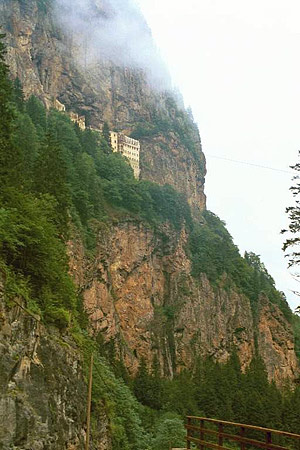 The Sumela Monastery The Sumela Monastery
|
From Trabzon a visit to Sumela Monastery is a must. It is located north of the city towards the mountains, the Pontic Alps with peaks reaching altitudes of 3,937 m (12,917 ft). Sumela is considered the most important Orthodox monastery after the ones on Mt. Athos and Mt. Sinai.
After leaving the Trabzon the view improves, lush hills, deep green colors with scattered houses (still the concrete box variety) perched on the slopes. The scenery reminds one of Hawaii, the same steep green slopes, with deep canyons carved by water falls. Soon in a deep gorge one reaches the end of the paved road that leads to Sumela. The gorge is lined with cedar trees, streams and running water was everywhere. The tall peaks above are covered with clouds. While the rough road does go further up, it is better to walk, following the narrow path, rather than to drive up the treacherous, steep, muddy road. The path is also very steep but the scenery is breathtaking. The monastery looms close to the clouds. The monastery can be glimpsed perched on the sheer rocks, clouds rolling by across the peaks and deep valleys. In many ways, the monastery looks like a much larger version of the monastery in Amorgos.
After reaching the monastery one is in for a shock. What you see from afar is only a shell of the outer wall. All of the monastery is actually a terrible ruin. The magnificent Byzantine frescoes are totally exposed to the elements, not even a canvas canopy to protect them. Most of them are brutally vandalized, many eyes have been gouged. Crude graffiti, both in Greek and Turkish, mars most of their surfaces. The view of the mountain peaks, hidden by clouds, is both dramatic and breathtaking. Every surface is wet by the dew. Water is everywhere. While very humid, the air is cool. A spring within the monastery drenches our thirst with sweet tasting ice cold water.
Reconstruction work was on going in 1999. They were bringing large stones, one at a time, with the cable car. The stones, which look totally foreign from the existing old masonry stones, were used to rebuild walls. It was not clear if they were actually following the original plan. This crude wall reconstruction was going on while the precious and irreplaceable frescoes remained unprotected. It is madness! It is depressing to see the condition and active destruction, in the not-too-distant past, of this Byzantine marvel and its present lack of protection, and misguided reconstruction.
Vazelon Monastery
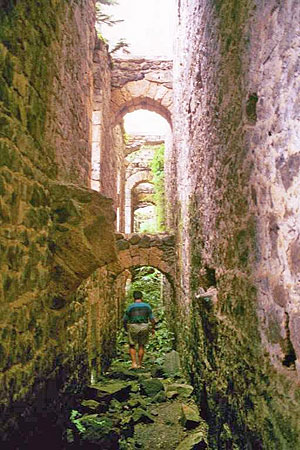 The Ruins of Vaselon Monastery The Ruins of Vaselon Monastery
|
Not far from Sumela is the abandoned Byzantine Monastery of Vaselon. According to the guide it is just a 15 km drive. After some difficulty, we found a faded sign for the monastery (1999). The distance written on the sign was hard to read, it could have been 3, 73, or 7 km. Following the sign we got onto a rough dirt road that goes up, and up. After somewhat more than 3 km we arrived at an alabalik (trout) restaurant, which is standing in the middle of nowhere among the steep green mountains. We drove some more. The road was deteriorating, becoming rougher and muddier, and after we crossed a rickety wooden bridge we got so scared that we parked and walked for about 30 minutes along the road. At the end of the road we took a steep and very slippery path that led us to the monastery. It was a pitiful sight! A total wreck. The little chapel, with some remaining magnificent but defaced frescoes, is used to store hay for the livestock. Manure was everywhere. A sizable local family had preceded us, the children having climbed up the treacherous walls into the monastery, and were now giving us advice how we too could get in. We followed them, more ruins, more manure, more defaced frescoes. Very, very sad. --Istioploos 18:47, 19 December 2008 (UTC)
Friends
Contact details of "Cruiser's Friends" that can be contacted for local information or assistance.
Forums
List links to discussion threads on partnering forums. (see link for requirements)
Links
- Trabzon at the Wikipedia
- Trabzon at the Wikivoyage
- Empire of Trebizond at the Wikipedia
- Sumela Monastery at the Wikipedia
References
Comments
We welcome users' contributions to the Wiki. Please click on Comments to view other users' comments, add your own personal experiences or recommend any changes to this page following your visit.
Verified by
Date of member's last visit to Trabzon and this page's details validated:
- August 1999 --Istioploos

 Travels with S/Y Thetis
Travels with S/Y Thetis
| This is a usable page of the cruising guide. However, please contribute if you can to help it grow further. Click on Comments to add your personal notes on this page or to discuss its contents. Alternatively, if you feel confident to edit the page, click on the edit tab at the top and enter your changes directly. |
| |
|---|
|
Names: Lighthouse, Istioploos |
